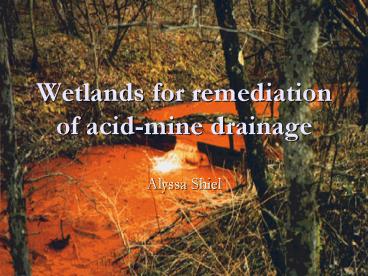Wetlands for remediation of acid-mine drainage - PowerPoint PPT Presentation
1 / 13
Title:
Wetlands for remediation of acid-mine drainage
Description:
Wetlands for remediation of acid-mine drainage Alyssa Shiel Overview Define acid-mine drainage Constructed wetlands as passive treatment systems Acid-tolerant aquatic ... – PowerPoint PPT presentation
Number of Views:62
Avg rating:3.0/5.0
Title: Wetlands for remediation of acid-mine drainage
1
Wetlands for remediation of acid-mine drainage
- Alyssa Shiel
2
Overview
- Define acid-mine drainage
- Constructed wetlands as passive treatment systems
- Acid-tolerant aquatic plants
- Benhar ironstone mine spoil in Central Scotland
3
Acid-mine drainage
- Drainage flowing from or caused by mining that
is typically highly acidic with elevated metal
levels - Increased concentrations of cadmium, nickel,
lead, zinc, copper and sulfates - The primary source of freshwater metal
contamination - Associated with land contamination and sparse
vegetation - May leach into surrounding watercourses
4
Acid-mine drainage
- Lowers pH, between 2.0 and 3.0
- Contaminates water with oils, cyanides, acids and
alkalies - Reduces buffering capacity
- Alters phosphorus availability
- Solubilizes some heavy metals
5
Constructed wetlands as treatment systems
- Viable treatment system for many mining regions
of the world - Passive, low-cost remediation
- Goals
- Removal of iron from the water column
- Removal of other metals
- Sulfate reduction
- Alleviation of extreme acidic conditions
6
Acid tolerant aquatic species
- Typha sp. (cattails)
- Sphagnum dominates
- Found to accumulate iron
- Green algaes
- Chlamydomonas aplanata (lt3)
- Blue-green algaes
- Spirulina nordstedtii (4.9)
- Diatoms
- Navicula nivalis (3.0)
(M. Kelly, 1988)
7
Benhar ironstone spoil heap in Central Scotland
- Acidic metal-rich drainage from reclaimed
ironstone mine spoil - 12 month evaluation of a constructed wetland
system
(Heal and Salt, 1999)
8
Benhar before remediation
9
Ironstone spoil
- Characterized by pH 2.7 and 247 mg/l total Fe
- Highly acidic with elevated metal concentrations
- Acidity may mobilize iron, manganese, aluminum
and other metals - Although mining ceased early in the 20th Century,
the Bing has remained mostly unvegetated due to
the highly acidic and infertile spoil - Mine drainage was polluting a small watercourse
which leads into the River Almond
10
Ironstone spoil
- Iron pyrites in ironstone and coal spoil are
oxidized to form sulfuric acid when exposed to
air and water - At pH above 4, acid production proceeds slowly
and is controlled by the rate of oxygen diffusion
into the spoil - Below pH 4, an alternative oxidation pathway
exists involving the bacterium Thiobacillus
ferrooxidans
11
Treatment
- Creating an aesthetically-pleasing landform
- Treatment with dried pelleted sewage sludge,
limestone and peat - After which trees were planted Betula pubescens
and Alnus glutinosa (common alder) - Construction of settling pond and surface flow
wetland to receive spoil drainage - Mushroom compost substrate
- Cattails (Typha latifolia).
12
Reclamation
- Acidity, iron, manganese and aluminum
concentrations declined - Removed on average 33 of acidity and 20-40 of
metal inputs - Removal rates decreased in the winter
- Enabled vegetation establishment
- Effect was spatially variable
13
Summary
- Constructed wetlands offer an inexpensive,
passive treatment for acid-mine drainage - Several acid-tolerant aquatic species including
Sphagnum and Typha sp. - Benhar mine spoil
- Site history
- Treatment
- Results

